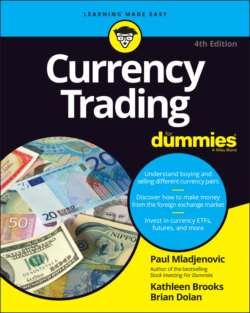Читать книгу Currency Trading For Dummies - Kathleen Brooks - Страница 58
Hedging for international trade purposes
ОглавлениеOne of the more traditional reasons for hedging in the forex market is to facilitate international trade. Say you’re a widget maker in Germany and you just won a large order from a UK-based manufacturer to supply it with a large quantity of widgets. To make your bid more attractive, you agreed to be paid in British pounds (GBP).
But because your production cost base is denominated in euros (EUR), you face the exchange rate risk that GBP will weaken against the EUR. That would make the amount of GBP in the contract worth fewer EUR back home, reducing or even eliminating your profit margin on the deal. To insure, or hedge, against that possibility, you would seek to sell GBP against EUR in the forex market. If the pound weakened against the euro, the value of your market hedge would rise, compensating you for the lower value of the GBP you’ll receive. If the pound strengthens against the euro, your loss on the hedge is offset by gains in the currency conversions. (Each pound would be worth more euros.)
Trade hedgers follow a variety of hedging strategies and can utilize several different currency hedging instruments. Currency options can be used to eliminate downside currency risk and sometimes allow the hedger to participate in advantageous price movements. Currency forward transactions essentially lock in a currency price for a future date, based on the current spot rate and the interest rate differentials between the two currencies.
Trade-related hedging regularly comes into the spot market in two main forms:
At several of the daily currency fixings: The largest is the London afternoon fixing, which takes place each day at 4 p.m. local time, which corresponds to 11 a.m. eastern time (ET). The Tokyo fixing takes place each day at 8:55 a.m. Tokyo time, which corresponds to 6:55 p.m. eastern time (ET). A fixing is a process where commercial hedgers submit orders to buy or sell currencies in advance. The orders are then filled at the prevailing spot rate (the rate is fixed) at the time of the fixing. The difference between the amount of buying and selling orders typically results in a net amount that needs to be bought or sold in the market prior to the fixing time. On some days, this can see large amounts (several billion dollars or more) being bought or sold in the hour or so leading up to the fixing time. After the fix, that market interest has been satisfied and disappears. Month-end and quarter-end fixings typically see the largest amounts of volume. Short-term traders need to closely follow live market commentaries to see when there is a substantial buying or selling interest for a fixing. (See Chapter 2 for more on potential future changes to the fixing process.)
Mostly in USD/JPY, where Japanese exporters typically have large amounts of USD/JPY to sell: Japanese exporters receive dollars for their exports, which must then be converted into JPY (sell USD/buy JPY). The Japanese export community tends to be closely knit and their orders are likely to appear together in large amounts at similar levels. Again, real-time market commentaries are the most likely source for individual traders to hear about Japanese exporter selling interest.
